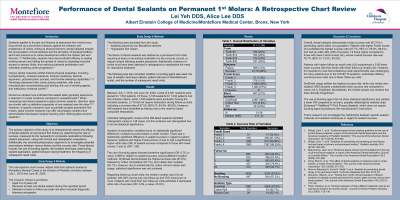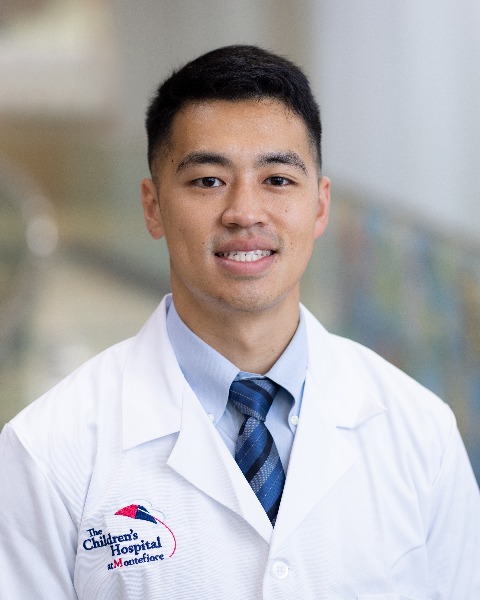Preventive
208 - Performance of Dental Sealants on Permanent 1st Molars: A Retrospective Chart Review


Lei Yeh, DDS
Pediatric Dental Resident
Montefiore Medical Center
Montefiore Medical Center
New York, New York, United States- AL
Alice Lee, DDS
Montefiore Medical Center
- AL
Alice Lee, DDS
Associate Director/Assistant Professor
Montefiore Medical Center
Bronx, New York, United States
Presenting Author(s)
Co-Author(s)
Program Director(s)
Purpose: The purpose of this study is to evaluate the success rate of dental sealants on permanent 1st molars placed from July 1, 2019 to June 30, 2020, and to determine any associations between variables of interest such as: use of bonding agent, isolation technique, patient behavior, and number of subsequent recall visits.
Methods: A retrospective chart review was completed over a one-year period of patients treated at Montefiore Medical Center’s Division of Pediatric Dentistry. Inclusion criteria includes patients aged 6-9 with a minimum of 1 dental sealant placed between the time period of July 1, 2019 - June 30, 2022, and with at least one follow-up recall visit with diagnostic radiographs taken. Exclusion criteria includes patients with existing sealants placed by outside dentists, hypoplastic 1st molars and patients that failed to return for a minimum of one recall visit. Failure of dental sealants is defined as a permanent first molar with at least one surface restoration the occlusal, buccal or lingual surfaces after sealant placement. As an attempt to standardize evidence of caries, carious teeth that require restorations will also be evaluated for radiographic evidence of caries. Exploratory variables will also be reviewed such as: use of bonding agent, type of isolation, patient behavior (Frankl Behavior Scale), and number of recall visits.
Results: A total of 4,651 sealants were placed for a total of 1,543 patients. Of those sealants, 1,545 were excluded due to sealants placed on teeth other than permanent 1st molars, teeth were hypoplastic, lack of follow-up or loss of records. After filtering through the inclusion criteria, a total of 3,106 sealants qualified for the study that were placed on a total of 1,042 patients. The total number of sealants that succeeded without a need for a restoration upon follow up visits was 2,718 and 388 sealants were deemed as failures due to the need for a composite restoration in the future. The overall success rate of the treatment was 87.5% (95% CI: (84.5%, 88.0%)). For the 388 sealants that had failed, each one was individually reviewed radiographically for purposes of standardization, and 148 sealants were evaluated to have radiographic caries. However, due to low numbers and data not being statistically significant, the radiographic evidence was disregarded. For the exploratory variables that were examined, there was no statistically significant difference regarding tooth number and sealant success. Patients were divided into combined subgroups of Frankl 1 and 2 compared to Frankl 3 and 4. Higher Frankl scores yielded an OR of 1.90 times higher sealant success rate for patients (p-value <0.001). The use of bonding agent was borderline significant with an OR of 0.76 (p-value 0.089) regarding sealant success. Regarding the use of different isolation methods, use of a Dryshield yielded the highest success rate (87.9%) followed by cotton roll isolation (87.7%) and rubber dam isolation being (62.1%); however, due to lower numbers, cotton roll and rubber dam isolation the data was not statistically significant. For follow-up recall visits, the median number was 2 for all patients with 25% of patients with one follow-up and 75% of patients with 2 or more. For patients with > 2 follow-up recall visits, there was a decreased OR of success of 0.59 (p-value <0.001).
Conclusion: Overall dental sealants yielded a high success rate (87.5%) in caries prevention within our population. Patients with higher Frankl scores (≥3; success rate of 87.7% (95% CI: 85.8 %, 89.4%) yielded the highest OR success rate of 1.9 compared to lower Frankl scores (≤2; overall success rate 78.7% (95% CI: 73.0 %, 83.5%). Patients with higher follow-up recalls (≥2) had 0.59 times lower success rate than low number of follow-up recalls (≤2); however, it is important to note that many patients had difficulty scheduling recall appointments due to the COVID-19 epidemic, causing overall success rates to be potentially slightly inflated due to lower numbers of follow-up. The use of Dryshield yielded the highest success rate, and only the use of rubber dam isolation (RDI) was statistically worse than the use of cotton roll or Dryshield; however, the sample size is lacking, making the data clinically insignificant. The use of bonding agent was not statistically significant, and yielded a lower OR compared to no bond, which may reflect upon the material used (Embrace Wetbond Pit &Fissure) which does not require use of bonding agent as stated by the manufacturer.
Identify Supporting Agency and Grant Number:

.jpg)